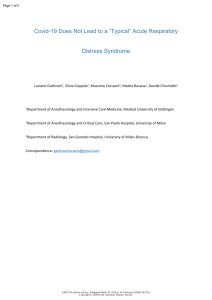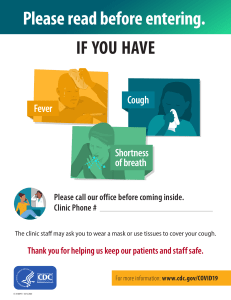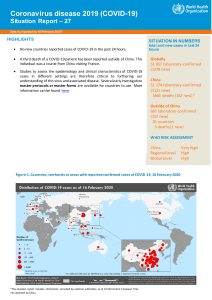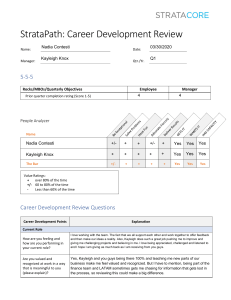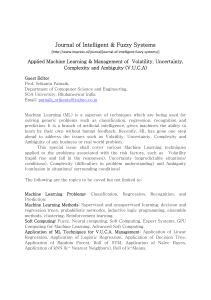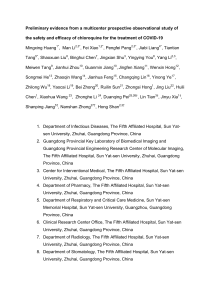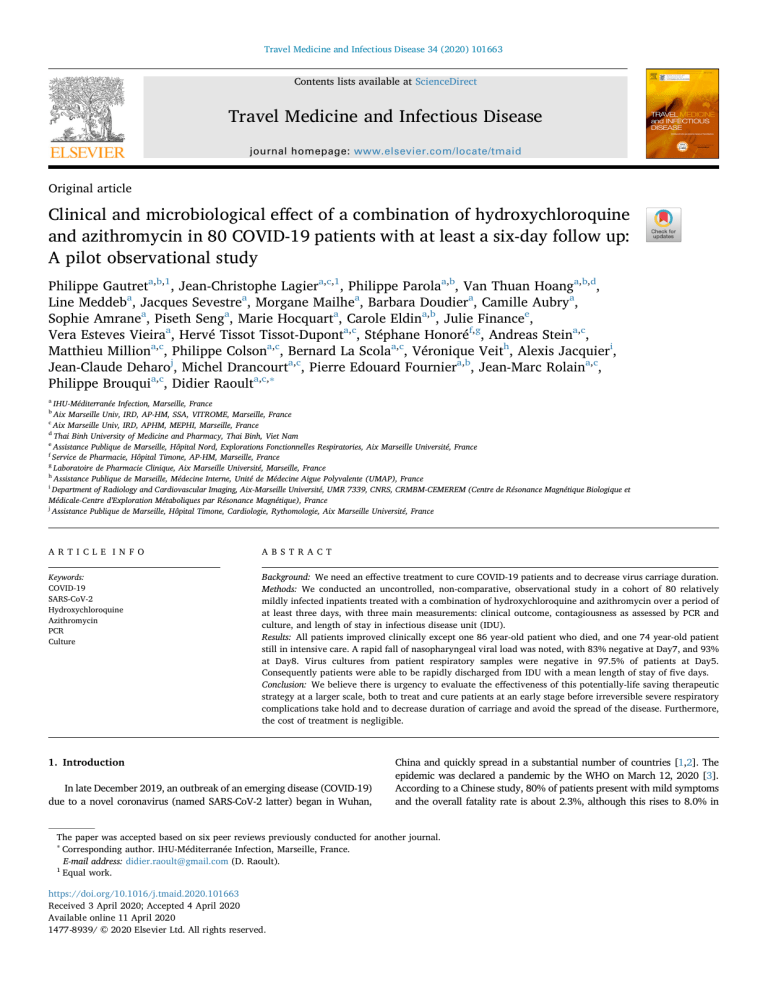
Travel Medicine and Infectious Disease 34 (2020) 101663 Contents lists available at ScienceDirect Travel Medicine and Infectious Disease journal homepage: www.elsevier.com/locate/tmaid Original article Clinical and microbiological effect of a combination of hydroxychloroquine and azithromycin in 80 COVID-19 patients with at least a six-day follow up: A pilot observational study T Philippe Gautreta,b,1, Jean-Christophe Lagiera,c,1, Philippe Parolaa,b, Van Thuan Hoanga,b,d, Line Meddeba, Jacques Sevestrea, Morgane Mailhea, Barbara Doudiera, Camille Aubrya, Sophie Amranea, Piseth Senga, Marie Hocquarta, Carole Eldina,b, Julie Financee, Vera Esteves Vieiraa, Hervé Tissot Tissot-Duponta,c, Stéphane Honoréf,g, Andreas Steina,c, Matthieu Milliona,c, Philippe Colsona,c, Bernard La Scolaa,c, Véronique Veith, Alexis Jacquieri, Jean-Claude Deharoj, Michel Drancourta,c, Pierre Edouard Fourniera,b, Jean-Marc Rolaina,c, Philippe Brouquia,c, Didier Raoulta,c,∗ a IHU-Méditerranée Infection, Marseille, France Aix Marseille Univ, IRD, AP-HM, SSA, VITROME, Marseille, France Aix Marseille Univ, IRD, APHM, MEPHI, Marseille, France d Thai Binh University of Medicine and Pharmacy, Thai Binh, Viet Nam e Assistance Publique de Marseille, Hôpital Nord, Explorations Fonctionnelles Respiratories, Aix Marseille Université, France f Service de Pharmacie, Hôpital Timone, AP-HM, Marseille, France g Laboratoire de Pharmacie Clinique, Aix Marseille Université, Marseille, France h Assistance Publique de Marseille, Médecine Interne, Unité de Médecine Aigue Polyvalente (UMAP), France i Department of Radiology and Cardiovascular Imaging, Aix-Marseille Université, UMR 7339, CNRS, CRMBM-CEMEREM (Centre de Résonance Magnétique Biologique et Médicale-Centre d'Exploration Métaboliques par Résonance Magnétique), France j Assistance Publique de Marseille, Hôpital Timone, Cardiologie, Rythomologie, Aix Marseille Université, France b c ARTICLE INFO ABSTRACT Keywords: COVID-19 SARS-CoV-2 Hydroxychloroquine Azithromycin PCR Culture Background: We need an effective treatment to cure COVID-19 patients and to decrease virus carriage duration. Methods: We conducted an uncontrolled, non-comparative, observational study in a cohort of 80 relatively mildly infected inpatients treated with a combination of hydroxychloroquine and azithromycin over a period of at least three days, with three main measurements: clinical outcome, contagiousness as assessed by PCR and culture, and length of stay in infectious disease unit (IDU). Results: All patients improved clinically except one 86 year-old patient who died, and one 74 year-old patient still in intensive care. A rapid fall of nasopharyngeal viral load was noted, with 83% negative at Day7, and 93% at Day8. Virus cultures from patient respiratory samples were negative in 97.5% of patients at Day5. Consequently patients were able to be rapidly discharged from IDU with a mean length of stay of five days. Conclusion: We believe there is urgency to evaluate the effectiveness of this potentially-life saving therapeutic strategy at a larger scale, both to treat and cure patients at an early stage before irreversible severe respiratory complications take hold and to decrease duration of carriage and avoid the spread of the disease. Furthermore, the cost of treatment is negligible. 1. Introduction China and quickly spread in a substantial number of countries [1,2]. The epidemic was declared a pandemic by the WHO on March 12, 2020 [3]. According to a Chinese study, 80% of patients present with mild symptoms and the overall fatality rate is about 2.3%, although this rises to 8.0% in In late December 2019, an outbreak of an emerging disease (COVID-19) due to a novel coronavirus (named SARS-CoV-2 latter) began in Wuhan, The paper was accepted based on six peer reviews previously conducted for another journal. ∗ Corresponding author. IHU-Méditerranée Infection, Marseille, France. E-mail address: [email protected] (D. Raoult). 1 Equal work. https://doi.org/10.1016/j.tmaid.2020.101663 Received 3 April 2020; Accepted 4 April 2020 Available online 11 April 2020 1477-8939/ © 2020 Elsevier Ltd. All rights reserved. Travel Medicine and Infectious Disease 34 (2020) 101663 P. Gautret, et al. patients between the ages of 70–79 years and to 14.8% in those aged 80 years and over [4]. However, it is highly likely that there are a large number of asymptomatic carriers in the population, and thus it is probable that the mortality rate has been overestimated. To take the example of the outbreak onboard the Diamond Princess cruise-ship, the fatality rate was 1.4% [5]. France is now facing the onslaught of COVID-19 with more than 25,000 cases, as March 26th, 2020 [5]. Thus, there is a critical and urgent need for an effective treatment in order to cure symptomatic patients but also to decrease the duration of virus carriage and thus limit transmission in the community. Among the candidate drugs to treat COVID-19, repositioning old drugs for use as an antiviral treatment is a compelling strategy, because knowledge about these drugs’ safety profile, side effects, pharmacokinetics and drug interactions are already well known [6,7]. According to an online survey conducted at the end of March, 33% of an international panel of physicians reported personally prescribing (or seeing colleagues prescribe) hydroxychloroquine (or chloroquine), and 41% reported the same for azithromycin (or similar antibiotics) to fight COVID-19. In addition, of those who have treated COVID-19 patients, 37% believe that hydroxychloroquine (or chloroquine) is the most effective therapy against the disease, and 32% believe the same for azithromycin (or similar antibiotics). Given that more than one third of physicians now prescribe these drugs to COVID-19 patients, it is of critical importance to evaluate the effectiveness of such medications (https://public-cdn.sermo. com/covid19/c8/be4e/4edbd4/dbd4ba4ac5a3b3d9a479f99cc5/wave-isermo-covid-19-global-analysis-final.pdf). Three studies have demonstrated that chloroquine phosphate inhibits SARS-CoV-2 [8-10] and two have demonstrated that hydroxychloroquine sulfate inhibits SARS-CoV-2 [8,9] in vitro. In addition, and in parallel to this study, we evaluated in vitro the combination of hydroxychloroquine and azithromycin on SARS-CoV-2 infected cells, and showed that there was a considerable synergy of these two substances when they were used at doses which mimic the concentrations likely to be obtained in humans (https://www.mediterranee-infection.com/wpcontent/uploads/2020/03/Andreani-et-al.-Pre-print-V2.pdf). Other studies have pointed out that drug repurposing may identify approved drugs that could be useful for the treatment of this disease including, notably, chloroquine, hydroxychloroquine and azithromycin, as well as anti-diabetics such as metformin, angiotensin receptor inhibitors such as sartans, or statins such as simvastatin [11]. In addition, chloroquine has demonstrated its efficacy in Chinese COVID-19 patients in clinical trials by reducing fever, improving CT imaging, and delaying disease progression [12–14], leading Chinese experts to recommend chloroquine-based treatment (500 mg twice per day for ten days) as a first line-treatment for mild, moderate and severe cases of COVID-19 [15]. In a preliminary clinical trial on a small cohort of COVID-19 patients, we demonstrated that those treated with hydroxychloroquine (600 mg per day, N = 20 patients) had a significant reduction in viral carriage at D6-post inclusion, with 70% of patients testing negative for the virus through nasopharyngeal PCR, compared to untreated controls (N = 16) with only 12.5% patients testing negative using PCR at D6post inclusion [16]. In addition, of the twenty patients who were treated with hydroxychloroquine, six received azithromycin for five days (for the purposes of preventing bacterial super-infection) and all (100%) were virologically cured at D6-post inclusion, compared to 57.1% of the remaining 14 patients [16]. By contrast, a Chinese study conducted in 30 COVID-19 patients showed no significant differences between patients treated with 400 mg per day during five days (N = 15) and controls (N = 15) regarding pharyngeal carriage of viral RNA at day7, however, patients received multiple additional treatments including antivirals [17]. Finally, another Chinese study conducted in 62 COVID-19 patients showed significantly shortened body temperature recovery time, cough remission time and larger proportion of improved pneumonia as assessed by CT scan in patients treated with 400 mg per day during five days (N = 31) than in controls (N = 31) [18]. A recent Chinese survey revealed that the median duration of viral shedding was 20.0 days (IQR 17.0–24.0) in survivors, but SARS-CoV-2 was detectable until death in non-survivors. The shortest observed duration of viral shedding among survivors was eight days, whereas the longest was 37 days [19]. Therefore, a treatment enabling the viral carriage to be cleared and COVID-patients to be clinically cured at an early stage of the disease would help limit the transmission of the virus. In this report we describe the results of an uncontrolled non-comparative observational study in a cohort of relatively mildly infected patients treated with hydroxychloroquine in combination with azithromycin over a period of at least three days, with three main endpoints: (i) clinical outcome (ii) contagiousness as assessed by PCR and culture and (iii) length of stay in infectious disease (ID) unit. 2. Methods 2.1. Study design and participants The study was conducted at the University Hospital Institute Méditerranée Infection in Marseille, France. Patients with PCR-documented SARS-CoV-2 RNA from a nasopharyngeal sample were admitted to our infectious diseases (ID) ward. It should be noted that the six patients under hydroxychloroquine and azithromycin combination enrolled at our institute who were described in our first paper, with a sixday follow-up (N = 6) [16], were also included in the present study, with a longer follow-up. 2.2. Clinical classification and clinical follow-up Upon admission, patients were grouped into two categories: (i) those with an upper respiratory tract infection (URTI) presenting with rhinitis and/or pharyngitis, and/or isolated low-grade fever and myalgia, and (ii) those with lower respiratory tract infections (LRTI) presenting with symptoms of pneumonia or bronchitis. The time between the onset of symptoms and admission, and the time between the onset of symptoms and treatment was documented. Risk factors for severe COVID-19, including older age, cancer, cardiovascular disease, hypertension, and diabetes [4], as well as chronic obstructive pulmonary disease, obesity and any immunosuppressive treatments were documented. The national early warning score (NEWS) for COVID-19 patients, was collected upon ward admission and during follow up. The NEWS score was calculated based on the following parameters: age, respiratory rate, oxygen saturation, temperature, systolic blood pressure, pulse rate and level of consciousness [20]. We defined three risk categories for clinical deterioration: low score (NEWS 0–4), medium score (NEWS 5–6), and high score (NEWS≥7) for COVID patients. The need for oxygen therapy, transfer to the intensive care unit (ICU), death, and length of stay in the ID ward were documented. 2.3. Chest computed tomography Patients systematically underwent an unenhanced chest low-dose computed tomography (LDCT) upon admission or soon after, using a single CT machine (Revolution EVO - GE Healthcare, WI, USA). All images were analysed by experienced chest radiologists, then classified as compatible or not compatible with pneumonia. Images were considered to be compatible in the presence of peripheral multifocal ground-glass opacities with or without reticulations, or in the presence of alveolar consolidation or crazy paving pattern. 2 Travel Medicine and Infectious Disease 34 (2020) 101663 P. Gautret, et al. 2.4. PCR assay 2.8. Criteria for contagiousness Nasopharyngeal swabs were collected on a daily basis until discharge with some exceptions. Some discharged patients were also sampled during follow-up at our out-patients department when possible. SARS-CoV-2 RNA was assessed by real-time reverse transcriptionPCR using a hydrolysis probe-based system that targets the gene encoding the envelope (E) protein [21], as previously described [21,22]. Negative results for viral RNA detection were defined as those with a cycle threshold (Ct) value ≥ 35. Patients with a PCR CT value of <34 were considered presumably contagious based on results of a study showing that culture are positive under this condition (https://www.mediterranee-infection.com/wpcontent/uploads/2020/03/La-Scola-et-al.3-IHU-draft.pdf). Patients with positive culture were considered contagious. 2.9. Outcome The primary endpoints were (i) an aggressive clinical course requiring oxygen therapy or transfer to the ICU after at least three days of treatment, (ii) contagiousness as assessed by PCR and culture, and (iii) length of stay in the ID ward. 2.5. Culture Cultures were attempted in a selected convenience sample of patients. A 500 μL aliquot of the liquid collected from the nasopharyngeal swab were passed through 0.22-μm pore sized centrifugal filter (Merck millipore, Darmstadt, Germany), and were then inoculated in wells on 96-well culture microplates, of which four wells contained Vero E6 cells (ATCC CRL-1586) in Minimum Essential Medium culture medium with 4% foetal calf serum and 1% glutamine. After centrifugation at 4000 g, microplates were incubated at 37 °C. Plates were observed every day for evidence of a cytopathogenic effect. The presumptive detection of the virus in supernatant was performed using SU5000 SEM (Hitachi) scanning electronic microscope and then confirmed by specific RT-PCR. 2.10. Statistics Variation of culture positivity rate was assessed statistically as the proportion of variance explained by Ct value and considered adequately fitted if the coefficient of determination [R2 statistic] was >50%. 2.11. Ethics statement The protocol was approved by the ethical committee of the University Hospital Institute Méditerranée Infection (N°: 2020–01). The study was performed according to the good clinical practices recommended by the Declaration of Helsinki and its amendments. This is a retrospective study on a cohort of patients receiving standard treatment following a research protocol previously registered (ANSM: 2020-000890-25, CPP Ile de France: 10 20.02.28.99113, EU Clinical Trials Register: 2020 207 -000890-25; This study is referenced as reference 16 of this paper). Since then, the use of hydroxychloroquine has been authorized by the French government to treat COVID 19 patients (such as it has been FDA approved in the USA). The addition of an antibiotic (here azithromycin) regularly used to treat respiratory infection, is also included standard therapeutic management of patients. All the patients were informed about the treatment they have received. There is no formal consent to sign in our institution by patients, to allow us perform anonymous observational retrospective studies in the context of standard therapeutic management of patients. 2.6. COVID treatment Patients with no contraindications (Supplementary document 1) were offered a combination of 200 mg of oral hydroxychloroquine sulfate, three times per day for ten days combined with azithromycin (500 mg on D1 followed by 250 mg per day for the next four days). For patients with pneumonia and NEWS score≥5, a broad spectrum antibiotic (ceftriaxone) was added to hydroxychloroquine and azithromycin. Twelve-lead electrocardiograms (ECG) were performed on each patient before treatment and two days after treatment began. All ECGs were reviewed by senior cardiologists. The treatment was either not started or discontinued when the QTc (Bazett's formula) was >500 ms. The risk benefit ratio of hydroxychloroquine and azithromycin combination was estimated by the infectologist and agreed with the cardiologist when the QTc was between 460 and 500 ms. The treatment was not started when the ECG showed patterns suggesting a channelopathy (i.e. lonq QT pattern, Brugada pattern, malignant early repolarisation pattern) and the risk-benefit ratio was discussed when it showed other significant abnormalities (i.e., pathological Q waves, left ventricular hypertrophy, left bundle branch block). In addition, any drug potentially prolonging the QT interval was discontinued during treatment. Symptomatic treatments, including oxygen, were added when needed. An ionogram and verification of serum potassium levels in particular, was systematically performed upon admission. When needed, standard blood chemistry was checked. 3. Results 3.1. Demographics and patient status at admission (Tables 1 and 2) A total of 80 patients with confirmed COVID-19 were hospitalised at the Méditerranée Infection University Hospital Institute (N = 77) and at a temporary COVID-19 unit (N = 3) with dates of entry from 3 to 21 March 2020. All patients who received treatment with hydroxychloroquine and azithromycin [16] for at least three days and who were followed-up for at least six days were included in this analysis. The median age of patients was 52 years (ranging from 18 to 88 years) with a M/F sex ratio of 1.1. 57.5% of these patients had at least one chronic condition known to be a risk factor for the severe form of COVID-19 with hypertension, diabetes and chronic respiratory disease being the most frequent. The time between the onset of symptoms and hospitalisation was on average five days, with the longest time being 17 days. 53.8% of patients presented with LRTI symptoms and 41.2% with URTI symptoms. Only 15% of patients were febrile. Four patients were asymptomatic carriers. The majority of patients had a low NEWS score (92%) and 53.8% of patients had LDCT compatible with pneumonia. The mean PCR Ct value was 23.4. 2.7. Criteria for discharge Criteria for discharge changed over the course of the study. Initially, patients with two successive negative nasopharyngeal samples resulting from PCR assay (CT value ≥ 35) were discharged. From 18 March, patients with a single nasopharyngeal sample with a PCR CT value ≥ 34 were discharged to their homes or transferred to other units for continuing treatment. Ultimately, because of a crucial need to admit new, untreated inpatients, inpatients already receiving treatment with a PCR CT value < 34, with good clinical outcome and good adherence to treatment were also discharged. When possible, further follow-up was continued in other units or through out-patient consultations. 3 Travel Medicine and Infectious Disease 34 (2020) 101663 P. Gautret, et al. Table 1 Sociodemographic characteristics and chronic conditions. n Age (years) Median Interquartile Min - Max [20–45] [45–50] [50–60] [60–70] [70–80] ≥80 Male Chronic conditions Cancer Diabetes Coronary artery disease Hypertension Chronic respiratory diseases Obesity Immunosuppressive treatment Non-steroid anti-inflammatory treatment Table 3 Treatment and outcome. % 52.5 42 20 24 12 21 13 5 5 43 62 88 30.0 15.0 26.2 16.2 6.3 6.3 53.8 5 9 6 13 8 4 4 2 6.3 11.2 7.5 16.3 10.0 5.0 5.0 2.5 n Oxygen therapy 12 Transfer to intensive care unit 3 Death 1 Discharged 65 Currently hospitalised ICU 1 Infectious disease ward 13 Other antibiotic intake 18 Possible adverse events Nausea or vomiting 2 Diarrhoea 4 Blurred visiona 1 Time from treatment initiation to discharge (n = 65) Mean ± SD 4.1 ± 2.2 Min - Max 1 Length of stay in infectious diseases ward (n = 65) Mean ± SD 4.6 ± 2.1 Min - Max 1 NEWS score in discharged patients (N = 65) 0–4 (low) 61 5–6 (medium) 4 ≥ 7 (high) 0 Table 2 Clinical status at admission. Time between onset of symptoms and hospitalisation Mean ± SD Min - Max Clinical classification Asymptomatic Upper respiratory tract infection symptoms Lower respiratory tract infection symptoms Fever Temperature in febrile patients Mean ± SD Min - Max Cough Rhinitis NEWS score (N = 75, 5 missing data) 0–4 (low) 5–6 (medium) ≥ 7 (high) Pulmonary CT-scanner within 72 h of admission Not performed Not consistent with pneumonia Consistent with pneumonia Viral load at inclusion (Ct) Mean ± SD Min - Max Time between onset of symptoms and treatment Mean ± SD Min - Max Treatment started on Day 0 Treatment started on Day 1 Treatment started on Day 2 Treatment started on Day 3 a n % 4.8 ± 5,6 1 17 4 33 43 12 5.0 41.2 53.8 15.0 38.6 ± 0.12 38.5 47 13 38.8 58.8 16.3 69 4 2 92.0 5.3 2.7 16 21 43 20.0 26.2 53.8 23.6 ± 4.3 14 33 4.9 ± 3.6 1 49 26 3 2 17 61.2 32.5 3.8 2.5 % 15.0 3.8 1.2 81.2 1.2 16.2 22.5 2.5 5.0 1.2 10 11 93.8 6.2 – After five days of treatment. 3.3. Clinical course (Table 3) The majority (65/80, 81.3%) of patients had favourable outcome and were discharged from our unit at the time of writing with low NEWS scores (61/65, 93.8%). Only 15% required oxygen therapy during their stay in our ID ward. Three patients were transferred to the ICU, of whom two improved and were then returned to the ID ward. One 74 year-old patient was still in ICU at the time of writing. Finally, one 86 year-old patient who was not transferred to the ICU, died in the ID ward (Supplementary Table 1). 3.4. Contagiousness as assessed by PCR ct value and culture (Figs. 1 and 2) A rapid fall of nasopharyngeal viral load tested by qPCR was noted, with 83% negative at Day7, and 93% at Day8. The number of patients presumably contagious (with a PCR Ct value < 34) steadily decreased overtime and reached zero on Day 12 (Fig. 1). A marked decrease was observed after six days of treatment. After ten days, two patients only were still presumably contagious with Ct values of 32 and 29 respectively. The proportion of patients with a Ct value > 34 significantly decreased overtime (R2 = 0.9). Virus cultures from patient respiratory samples were negative in 97.5% patients at Day5. The number of contagious patients (with positive culture) early decreased after three days of treatment (Fig. 2). After five days of treatment, two patients only were contagious. On Day8 post-treatment only one of these two patients was contagious and ceased to be contagious on Day 9. The proportion of negative culture significantly decreased overtime (R2 = 0.8). 3.5. Length of stay in the ID ward 3.2. Hydroxychloroquine and azithromycin combined treatment (Tables 2 and 3) Of the 65 patients who were discharged from the ID ward during the study period, the mean time from initiation to discharge was 4.1 days with a mean length of stay of 4.6 days. The mean time between the onset of symptoms and the initiation of treatment was 4.9 days and most patients were treated on the day of admission or on the day after (93.7%). A total of 79/80 patients received treatment on a daily basis throughout the whole study period, which lasted a maximum of ten days. In one patient, the treatment had to be stopped on Day 4 because, although it was well tolerated there was a potential risk of interaction with another drug. Adverse events were rare and minor. 4. Discussion COVID-19 poses two major challenges to physicians. The first is the therapeutic management of patients. In this context, it is necessary to avoid a worsening evolution, which usually occurs around the tenth day and may result in acute respiratory distress 4 Travel Medicine and Infectious Disease 34 (2020) 101663 P. Gautret, et al. Fig. 1. SARS-CoV-2 PCR from nasopharyngeal samples overtime. Black bars: number of patients with available results, grey bars: number of patients with PCR Ct value < 34, solid line: percentage of patients with PCR Ct value < 34, dashed line: logarithmic regression curve. syndrome, the prognosis of which, in particular in the elderly, is poor, whatever the cause. Therefore, the primary therapeutic objective is to treat people who have moderate or severe infections at an early enough stage to avoid progression to a serious and irreversible condition. By administering hydroxychloroquine combined with azithromycin, we were able to observe an improvement in all cases, except in one patient who arrived with an advanced form, who was over the age of 86, and in whom the evolution was irreversible. For all other patients in this cohort of 80 people, the combination of hydroxychloroquine and azithromycin resulted in a clinical improvement that appeared superior when compared to outcomes of other hospitalised patients, as described in the literature. In a cohort of 191 Chinese inpatients, of whom 95% received antibiotics and 21% received a combination of lopinavir and ritonavir, the median duration of fever was 12 days and that of cough 19 days in survivors, with a 28% case-fatality rate [19]. The favourable evolution of our patients under hydroxychloroquine and azithromycin paralleled a relatively rapid decrease in viral RNA load as assessed by PCR, which was even more rapid when assessed by culture. These data are important to compare with that of the literature which shows that the viral RNA load can remain high for about three weeks in most patients in the absence of specific treatment [19,23] with extreme cases lasting for more than a month. A study conducted in 76 Chinese COVID19 inpatients showed that high viral RNA load is associated with the severity of the disease [24]. Furthermore, in a study conducted on a small group of 16 Chinese COVID-19 inpatients, viral RNA was positively detected in 50% of them, after resolution of symptoms for a Fig. 2. SARS-CoV-2 culture from nasopharyngeal samples overtime. Black bars: number of patients with available results, grey bars: number of patients with positive culture, solid line: percentage of patients with a positive culture, dashed line: logarithmic regression curve. 5 Travel Medicine and Infectious Disease 34 (2020) 101663 P. Gautret, et al. Cortaredona, Patrick Peretti-Watel, Pierre Verger, Yolande Obadia, and all the clinical, technical and paramedical staffs of the hospitalisation units and laboratories for their support in this difficult context. median duration of 2.5 days and a maximum of eight days [25]. Therefore, the rapid decrease in viral RNA load is one element suggesting the effectiveness of this treatment. Furthermore, to our knowledge, the measurement of viral culture during treatment was also evaluated for the first time. The fall in culture positivity from the second day is remarkable, although, in a relatively small number of cases, some people maintain a positive culture. The second challenge is the rapid spread of the disease in the population through contagious individuals. The elimination of viral carriage in the human reservoir of the virus has recently been recognised as a priority [26]. To this end, the rapid decease in positivity in cultures from patients’ respiratory samples under treatment with hydroxychloroquine plus azithromycin supports an effectiveness of this combination. Thus, in addition to its direct therapeutic role, this combination can play a role in controlling the disease epidemic by limiting the duration of virus shedding, which can last for several weeks in the absence of specific treatment. In our Institute, which contains 75 individual rooms for treating highly contagious patients, we currently have a turnover rate of 1/3 per day which allows us to receive a large number of these contagious patients with early discharge. Chloroquine and hydroxychloroquine are extremely well-known drugs which have already been prescribed to billions of people. Because of anecdotical reports of heart complications with such drugs in patients with underlying conditions, it would be useful to perform an ECG before or at the very beginning of the treatment [27]. This problem is solved by hospitalising patients at risk in continuing care units with ECG monitoring allowing for the early detection and treatment of possible cardiac side-effects. Azithromycin is the drug that has been the most widely prescribed against respiratory infections and a recent (2010) study showed that one in eight American patients, has been prescribed azithromycin [28]. Indeed, there have probably been more than a billion azithromycin prescriptions around the world since it was first discovered. The toxicity of each of these two drugs does not, therefore, pose a major problem. Their possible toxicity in combination has been suggested in a few anecdotal reports but, to our knowledge, has never been demonstrated. Our work has some limitations. This is a descriptive pilot study conducted in only 80 patients with relatively mild clinical presentation and we did not attempt an analytic approach to account for possible confounding factors including notably the severity of illness. Such an approach is currently planned in a larger set of patients under treatment in our institute. In conclusion, we have provided evidence of a beneficial effect of co-administration of hydroxychloroquine with azithromycin in the treatment of COVID-19 and its potential effectiveness in the early reduction of contagiousness. Given the urgent therapeutic need to manage this disease with effective and safe drugs, and the negligible cost of both hydroxychloroquine and azithromycin, we believe that there is an urgent need to evaluate this strategy further, both to treat and cure patients at an early stage before irreversible severe respiratory complications take hold, and to decrease duration of carriage and avoid the spread of the disease. Appendix A. Supplementary data Supplementary data to this article can be found online at https:// doi.org/10.1016/j.tmaid.2020.101663. References [1] Lai CC, Shih TP, Ko WC, Tang HJ, Hsueh PR. Severe acute respiratory syndrome coronavirus 2 (SARS-CoV-2) and coronavirus disease-2019 (COVID-19): the epidemic and the challenges. Int J Antimicrob Agents 2020;55:105924. [2] Zhu N, Zhang D, Wang W, Li X, Yang B, Song J, et al. A novel coronavirus from patients with pneumonia in China, 2019. N Engl J Med 2020;382:727–33. [3] WHO Director-General's opening remarks at the media briefing on COVID-19 - 11 March 2020. 2020https://www.who.int/dg/speeches/detail/who-director-generals-opening-remarks-at-the-media-briefing-on-covid-19-11-march-2020. [4] Wu Z, McGoogan JM. Characteristics of and important lessons from the coronavirus disease 2019 (COVID-19) outbreak in China: summary of a report of 72314 cases from the Chinese center for disease control and prevention. J Am Med Assoc 2020. [5] Coronavirus COVID-19 global cases by the center for systems science and engineering (CSSE) at johns Hopkins University (JHU) accessed on March, 26th, 2020 from https://gisanddata.maps.arcgis.com/apps/opsdashboard/index.html#/ bda7594740fd40299423467b48e9ecf6. [6] Colson P, Rolain JM, Raoult D. Chloroquine for the 2019 novel coronavirus SARSCoV-2. Int J Antimicrob Agents 2020:105923. [7] Colson P, Rolain JM, Lagier JC, Brouqui P, Raoult D. Chloroquine and hydroxychloroquine as available weapons to fight COVID-19. Int J Antimicrob Agents 2020:105932. [8] Yao X, Ye F, Zhang M, Cui C, Huang B, Niu P, et al. In vitro antiviral activity and projection of optimized dosing design of hydroxychloroquine for the treatment of severe acute respiratory syndrome coronavirus 2 (SARS-CoV-2). Clin Infect Dis 2020. [9] Liu J, Cao R, Xu M, Wang X, Zhang H, Hu H, et al. Hydroxychloroquine, a less toxic derivative of chloroquine, is effective in inhibiting SARS-CoV-2 infection in vitro. Cell Discov 2020;6:16. [10] Wang M, Cao R, Zhang L, Yang X, Liu J, Xu M, et al. Remdesivir and chloroquine effectively inhibit the recently emerged novel coronavirus (2019-nCoV) in vitro. Cell Res 2020;30:269–71. [11] Nabirothckin S, Peluffo AE, Bouaziz J, Cohen D. Focusing on the unfolded protein response and autophagy related pathways to reposition common approved drugs against COVID-19. Preprints 2020. https://doi.org/10.20944/preprints202003. 0302.v1. [12] Gao J, Tian Z, Yang X. Breakthrough: chloroquine phosphate has shown apparent efficacy in treatment of COVID-19 associated pneumonia in clinical studies. Biosci Trends 2020. [13] Chinese Clinical Trial Registry. http://www.chictr.org.cn/searchproj.aspx?title. [14] Zhou D, Dai SM, Tong Q. COVID-19: a recommendation to examine the effect of hydroxychloroquine in preventing infection and progression. J Antimicrob Chemother 2020. [15] Expert consensus on chloroquine phosphate for the treatment of novel coronavirus pneumonia. Zhonghua Jiehe He Huxi Zazhi 2020;43:185–8. [16] Gautret P, Lagier JC, Parola P, Hoang VT, Meddeb L, Mailhe M, et al. Hydroxychloroquine and azithromycin as a treatment of COVID-19: results of an open-label non-randomized clinical trial. Int J Antimicrob Agents 2020:105949. [17] Chen J, Liu D, Liu L, Liu P, Xu Q, Xia L, et al. A pilot study of hydroxychloroquine in treatment of patients with common coronavirus disease-19 (COVID-19). J of Zjeijang University; 2020. [18] Chen Z, Hu J, Zhang Zo, Jiang S, Han S, Yan D, et al. Efficacy of hydroxychloroquine in patients with COVID-19: results of a randomized clinical trial. MedRxiv 2020. https://doi.org/10.1101/2020.03.22.20040758. [19] Zhou F, Yu T, Du R, Fan G, Liu Y, Liu Z, et al. Clinical course and risk factors for mortality of adult inpatients with COVID-19 in Wuhan, China: a retrospective cohort study. Lancet 2020. [20] Liao X, Wang B, Kang Y. Novel coronavirus infection during the 2019-2020 epidemic: preparing intensive care units-the experience in Sichuan Province, China. Intensive Care Med 2020;46:357–60. [21] Corman VM, Landt O, Kaiser M, Molenkamp R, Meijer A, Chu DKW, et al. Detection of 2019 novel coronavirus (2019-nCoV) by real-time RT-PCR. Euro Surveill 2020:25. [22] Amrane S, Tissot-Dupont H, Doudier B, Eldin C, Hocquart M, Mailhe M, et al. Rapid viral diagnosis and ambulatory management of suspected COVID-19 cases presenting at the infections diseases referral hospital in Marseille, France, -January 31st to March 1st, 2020: a respiratory virus snapshot. Trav Med Infect Dis 2020. in press. [23] To KK, Tsang OT, Leung WS, Tam AR, Wu TC, Lung DC, et al. Temporal profiles of viral load in posterior oropharyngeal saliva samples and serum antibody responses during infection by SARS-CoV-2: an observational cohort study. Lancet 2020. Published on line March 23,2020. Financial support This study was supported by the Institut Hospitalo-Universitaire (IHU) Méditerranée Infection, the National Research Agency under the program « Investissements d'avenir », reference ANR-10-IAHU-03, the Région Provence Alpes Côte d’Azur and European funding FEDER PRIMI. Acknowledgements We thank Christine Zandotti, Laetitia Ninove, Céline Boschi, Véronique Filosa, Marion Bechet, Ahmed Yacine Belkhir, Sébastien 6 Travel Medicine and Infectious Disease 34 (2020) 101663 P. Gautret, et al. [24] Liu Y, Yan LM, Wan L, Xiang TX, Le A, Liu JM, et al. Viral dynamics in mild and severe cases of COVID-19. Lancet Infect Dis 2020. [25] Chang Mo G, Yuan X, Tao Y, Peng X, Wang F, et al. Time kinetics of viral clearance and resolution of symptoms in novel coronavirus infection. Am J Respir Crit Care Med 2020. [26] Mitja O, Clotet B. Use of antiviral drugs to reduce COVID-19 transmission. Lancet Glob Health 2020. [27] Chatre C, Roubille F, Vernhet H, Jorgensen C, Pers YM. Cardiac complications attributed to chloroquine and hydroxychloroquine: a systematic review of the literature. Drug Saf 2018;41:919–31. [28] Hicks LA, Taylor Jr. TH, Hunkler RJ. U.S. outpatient antibiotic prescribing, 2010. N Engl J Med 2013;368:1461–2. 7


